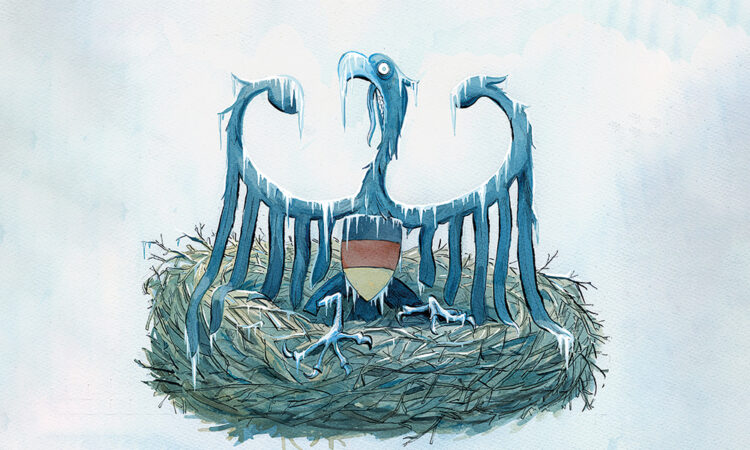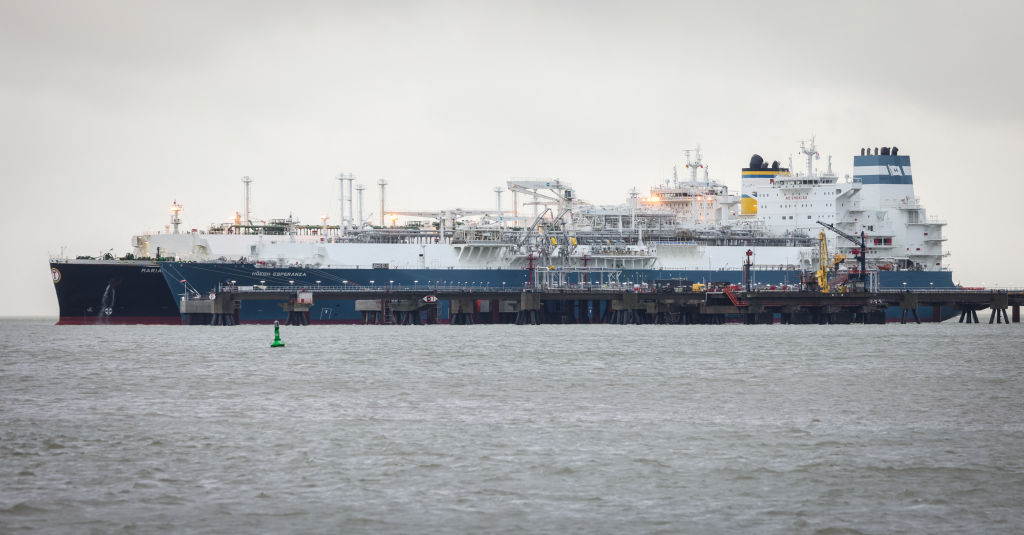
The Kremlin propaganda channel RT recently produced a festive video message for its overseas audiences. Somewhere in ‘Europe, Christmas 2021’ a happy family gathers in a cosy, Ikea-furnished house. A young girl cradles her present: an adorable hamster. Fast forward to Christmas 2022: the family huddles, freezing, under a blanket in a room illuminated only by the feeble glow of fairy lights powered by a tiny generator hooked up to the hamster’s exercise wheel. By Christmas 2023 the luckless Europeans, starving and shivering, celebrate with a thin soup made of… you got it. ‘Merry anti-Russian Christmas!’ trolls the final caption. ‘If your media doesn’t tell you where this is all going, RT is available via VPN.’
In one sense, the advert is perfectly accurate. Threatening Europe with a freezing winter without Russian gas was precisely the Kremlin’s plan to prevent Nato from coming to the aid of Ukraine. But instead of rolling power cuts, factory shutdowns, mass protests and economic collapse, Europe’s midwinter gas prices last week fell to pre-war levels. Germany’s gas storage facilities – by far the largest on the continent – were more than 90 per cent full, a near historical high for the time of year. The US now supplies 30 per cent of the continent’s gas via liquefied natural gas (LNG) shipments. And Robert Habeck, deputy head of Germany’s government and minister for the economy, announced that Russia’s share of Germany’s energy supplies would be reduced to practically zero in 2023.
‘The German problem, or the central European problem, was that half of our eggs were in the basket of Putin,’ said Habeck during a visit to Norway, now Germany’s biggest European gas supplier, last week. ‘And he destroyed them.’ Instead of bringing Europe to its knees and forcing Berlin to do his bidding, Putin’s clumsy attempt at weaponising energy has blown up in his face. Gazprom – the gas giant whose revenues fund a quarter of Russian state spending – reported that exports were down by 45 per cent. Thanks to a massive spike in energy prices over the summer, Russia’s GDP ended the year just 3.2 per cent down (as opposed to a pre-war projected 3 per cent growth). But with not just gas but also Urals crude oil prices plummeting to just over $50 a barrel – barely more than the extraction cost of $42-47 – this promises to be a year of economic devastation for Russia.
The gas war of 2022 has been won only at a serious cost to Europe’s economies
What went wrong with Putin’s plan to freeze Europe? First and foremost, the Kremlin made a critical mistake in playing its gas card too early. Hastily assembled post-invasion EU and US economic sanctions on Russia crucially did not include oil and gas. Instead, from May onwards Russia decided effectively to sanction itself by reducing gas flows to Germany through Gazprom’s Nord Stream 1 pipeline, citing technical reasons. The Kremlin’s idea was that rattling the gas sabre would dissuade Europeans from backing Ukraine’s unexpectedly fierce resistance.
Instead the EU did the opposite, streamlining cross-border gas storage and supply systems, building a series of pop-up floating terminals along the North Sea coast to unload LNG and, most crucially, splurging massively on buying up all available supplies of LNG across the globe. The strategy was crippling expensive. In late summer, at the height of the scramble to fill storage capacity, spot gas prices on the continent were 20 times higher than 2020 levels. But it worked. Even when a series of still-unexplained underwater explosions wrecked three of Gazprom’s four Nord Stream pipelines under the Baltic in late September, gas prices continued to fall. US oil companies, in a textbook example of the effectiveness of profit in motivating innovation and construction, massively and rapidly ramped up their LNG production and export capacity. By October some 30 LNG tankers were waiting off Europe’s coasts to unload their liquid gas.
Habeck – Germany’s most prominent Green politician – was robustly pragmaticabout the need to compromise his zero carbon principles by reopening the country’s shuttered coal-fired power stations and delaying the closure of its remaining nuclearpower plants. The EU’s Ursula von der Leyen appealed to Europeans to use 15 per cent less energy in the coming winter. The Germans responded by cutting consumption by 20 per cent.

Then there was luck. This winter has been astonishingly mild, significantly reducing heating needs across the continent. China’s lockdown also depressed the economy and reduced its appetite for LNG, making Japan (temporarily) the biggest consumer in Asia. That’s important, because until Qatar’s massive offshore North Field gas comes online in 2026, there is not enough global capacity to supply easily both Asia’s post-Covid and Europe’s post-Gazprom’s thirst for LNG.
How did Putin and his inner circle of advisers get it so wrong? Partly they were, not unreasonably, basing their assumptions on what would happen in the future on what had happened in the past. After Russia annexed Crimea in February 2014, then German chancellor Angela Merkel insisted that ‘territorial integrity is the foundation pillar of our postwar European order… If you start saying things like “it’s my right” and then just take something, you’ll end up with an incredible calamity.’ Yet just over a year later Merkel’s government – ignoring fierce objections from the US that Europe was already too dependent on Putin for its energy – signed a €10 billion deal with Gazprom to build a second major pipeline which would have doubled Germany’s supplies of Russian gas. In the event Nord Stream 2 was never certified – though one of its twin pipes survived September’s attack and it could, in theory, come back online and provide 25 billion cubic metres (BCM) of gas a year. But politically that cannot happen until long after the war is over.
Putin overestimated the relative political power of Germany’s industrial lobby – which had pressed hard for Nord Stream 2 – vs German, and European, public opinion. Last year, public outrage over Putin’s invasion beat economic self-interest. But Putin’s gas war of 2022 has nonetheless been won only at a serious cost to Europe’s economies. Collectively, last year the EU and Britain spent almost three times more on energy than in 2020 – including a staggering $780 billion on energy subsidies to private and business consumers, according to Ben Aris of bne IntelliNews a news portal based in Berlin. ‘The German economic model has been fundamentally damaged,’ says Aris. ‘Cheap energy was the basis of the industrial sector, especially chemicals… Germany is no longer an export powerhouse, which is why they want to get their cheap gas back.’ In May last year, Germany posted its first trade deficit in 30 years. Its economy is expected to contract by 0.3 per cent. And high fuel prices throughout 2022 were also a leading driver of economically damaging Europe-wide inflation, topping 20 per cent in the Baltic states. Protests organised by pro-Russia parties broke out in the Czech Republic and Germany against the cost-of-living crisis and government support for Ukraine – exactly the effect that Putin had hoped for, but as yet small and localised.
There are signs that Putin is ready to admit de facto defeat in his gas war. Last month, with little fanfare, the Russian government amended its March 2022 decree requiring all of Gazprom’s European customers to pay in rubles to once again allow the settlement of debts in hard currency. There is talk among Gazprom executives of reopening the Yamal-Europe pipeline that runs via Belarus into Poland, which was closed at the beginning of the war.
Some parts of Putin’s energy empire remain intact. Turkey, which has not signed up to EU sanctions, still gets some 32 BCM of gas from Russia via two pipelines under the Black Sea. And bizarrely, at least three major pipelines are still transporting some 18 BCM a year of Russian gas through Ukraine, earning Ukraine’s Naftogaz some $2 billion in transit fees. The pipelines run into Slovakia and on to central Europe – though one has been reversed so that the Russian gas exported to Slovakia can flow back into Ukraine. That allows Kyiv to maintain the fiction that Ukraine is not importing gas from its arch enemy, though in fact it is. Ironically, Ukraine’s Naftogaz pays the bills in part using the gas transit fees paid by Gazprom – though a lawsuit is under way over alleged underpayment by Moscow.

The big winner of Putin’s failed gas war is the US (and to a lesser extent Canada), whose energy companies earned an extra $1 trillion last year – dwarfing the $55 billion Washington has pledged to date to assist Ukraine. Over just ten months, US production has risen so fast that it now ties with Qatar as the world’s biggest LNG producer. It supplies almost as much gas to Europe as Gazprom did just a year before.
Putin’s war has killed Gazprom as the country’s economic powerhouse
The big loser is, of course, Russia. Putin’s war has killed Gazprom as the country’s economic powerhouse. Dreams of switching supply to China will remain dreams until the projected $25 billion, 2,600km Power of Siberia 2 pipeline is built. Currently, Russia exports just 12 BCM to China, compared with the 180 BCM that Gazprom used to sell to Europe. Oil and gas were the foundations of the economic boom that supported Putin’s power and prosperity. Without them, Russia risks a repeat of the 1990s, turning what was recently the world’s largest energy exporter into a failed state. Though Russians will not freeze, RT’s nasty Christmas adverts will be a glimpse not into Europe’s future economic collapse but Russia’s.
Owen Matthews is the author of Overreach: The Inside Story of Putin’s War Against Ukraine.







